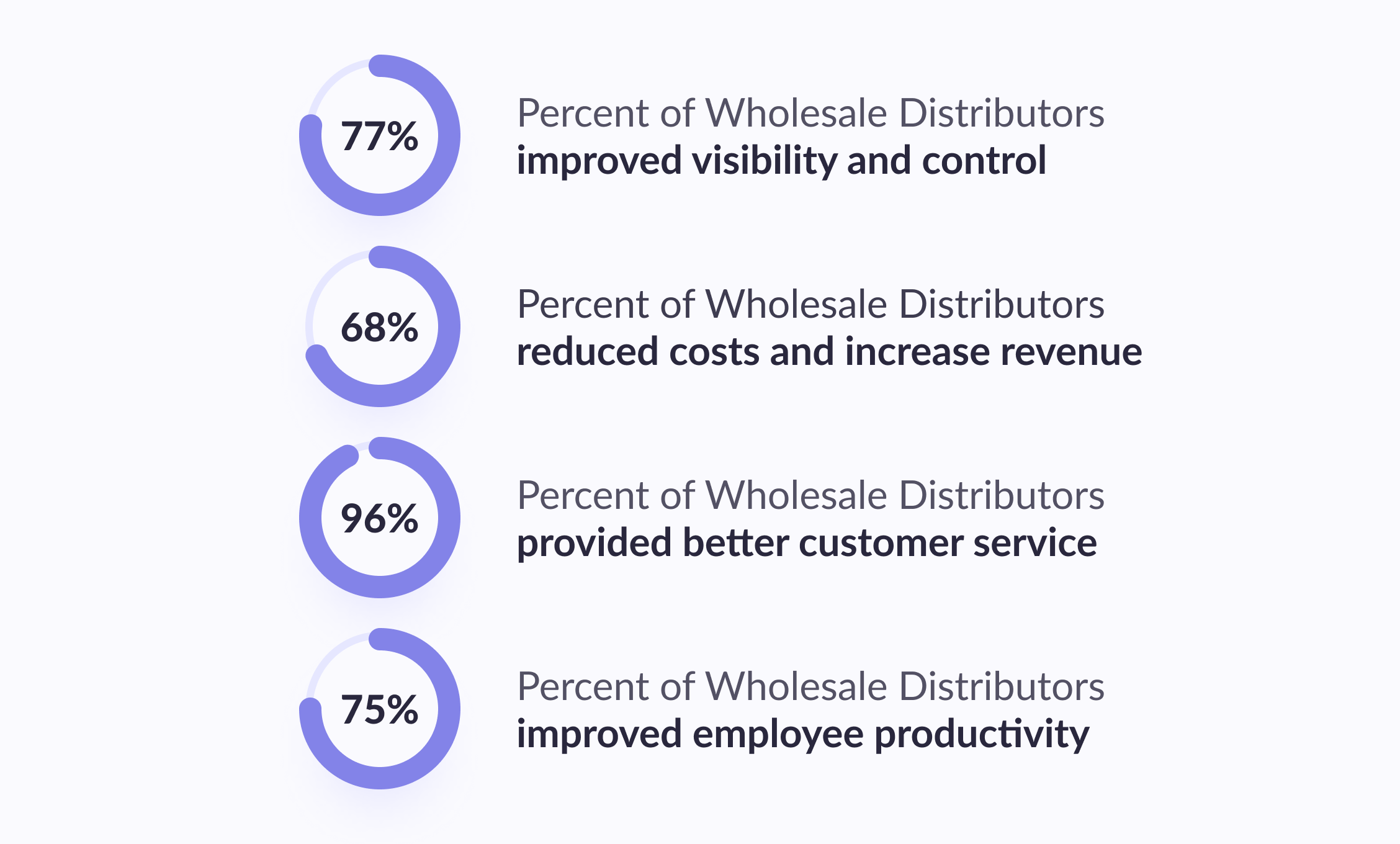The sheer volume of waybills, inventory lists, invoices, purchase orders, and sales orders creates problems for many wholesalers. However, continuous tracking of goods received and products shipped to customers is critical to accurate inventory counts, shipping times, and overall company financial reporting.
Despite the fact that digitalization has made life easier for companies of various sizes for several years now, many wholesale companies still have to process a significant amount of "paper'' documents. The only way to do this is, of course, through manual data entry. However, re-entry of data is time-consuming, error-prone, and ultimately simply hinders the growth of any company.
Let's talk about wholesale trading, the challenges it faces, process automation, and software that can help you to increase your eCommerce business's effectiveness.
In this Article:
What is Wholesale Trading
Wholesale represents the activity associated with the supply of goods and services to market intermediaries, retailers, or corporate customers. Wholesale trade does not include the marketing activities of manufacturers and retailers. The value of a wholesale and intermediary activity is reflected in the following economic categories:
- Sale and promotion. Wholesalers make it easier for manufacturers to reach more corporate buyers. Wholesalers have extensive connections, which makes buyers more likely to trust the trade than a completely unknown manufacturer.
- Procurement and assortment formation. Wholesalers make a selection of goods and competently plan the assortment, saving retailers from unnecessary work, although this condition is largely dictated by the competitive factor.
- Mass character (wholesale sampling of goods). The wholesale organization helps the corporate client to save money by supplying goods at lower costs and prices.
- Warehousing. Wholesalers are engaged in storing goods, thereby reducing the costs and risks of suppliers and buyers.
- Transportation. Wholesalers deliver faster to customers because they are closer to them than the manufacturer.
- Financing. The wholesaler finances customers by providing loans and paying for large quantities of goods.
- Risk acceptance. Wholesalers assume part of the risk by taking ownership of the goods and assuming the losses associated with theft, damage, deterioration, overpricing, and obsolescence of the goods.
- Marketing information. Wholesale companies provide suppliers and buyers with information about the activities of competing firms, the emergence of new products, and price changes.
- Management and consulting services. Wholesalers often provide support to retailers by training salespeople, participating in-store layouts and window dressing, and installing new inventory and inventory management systems. In addition, they provide corporate buyers with staff training and maintenance services for the supplied retail equipment.

Main Challenges of Wholesale Trading
The traditional mechanics of wholesale sales are often at risk. We have identified five main problems that wholesale suppliers face.
1. Dependence on the competence of employees
The manager can take a long time to respond to incoming applications, quarrel with the client, and forget about the application. This can cause a decrease in the number of sales and customers. Also, an employee can make a mistake when forming supply lots since some goods may have similar parameters. The result of such an error may be the dissatisfaction of the client and his demand for a refund.
2. Rapidly changing customer demand
Perhaps the biggest challenge distributors are facing is that customers' demand changes every month. To deal with this challenge, you need high-level analysis tools that can track and predict the demand changes.
3. Ongoing training for managers
When a new product appears, managers are required to undergo training in order to understand how to sell the new product. This requires additional administrative costs.
4. Lack of New Technologies
In order to stay competitive in the wholesale distribution industry, you need to implement new technologies. However, it may take a lot of money and time to start using new technologies in order to get all benefits of these technological advancements.
5. Inventory management
Inventory management is one of the most important processes in wholesale trading. Traditionally, inventory management was mostly done in two ways: Either manually by counting each item (which gets out of hand very quickly) or semi-automatically by using RFID tags, which are too expensive for most distributors.
The lack of wholesale automation causes many systematic errors that harm the balance sheet.

Main E-Commerce trends
Trends that will be relevant in the upcoming years
Do you want to run a successful business in the next few years? Look into the future now!
Check it outWhat is Wholesale Automation
Wholesale Automation is a solution that integrates important business processes such as shipping, financial management, production, finance, and customer service in one place. This allows you to optimize work processes. For example, you can set up an automatic reorder from a specific supplier when inventory levels reach a certain threshold. Materials can be automatically reordered by storing data across the organization in a centralized system. At the same time, you do not have to spend manual effort; employees will be able to work on other tasks.
Benefits of Wholesale Automation
Wholesale Automation is a way for a business to reach a new level. It helps to solve all those problems that prevent your business from developing, speeds up processes that take a lot of your time, and benefits all participants in the process.
1. Eliminate repetitive manual data entry
In wholesale business operations, there are certain data that several departments require at once. For example, when a company receives an order from a customer, the information will first be key to the customer's sales invoice. The same information will then be entered into the accounting platform. The same information will then be entered into the production team's packing list for the team to prepare the customer's order.
That is, without automation, you will need to manually enter the same data three times. If your business processes a large number of orders every day, this will be an extremely time-consuming process, and it will also significantly slow down the transaction time. What's more, if a customer makes changes to their order, the same slow process will have to be repeated over and over again.
Automating the data entry process simplifies the entire process of working with information. This solution will help eliminate the need to change key data and reduce the time spent on manual entry. Now your business can direct employees to perform more important tasks instead of wasting time on repetitive tasks.
2. Fewer administrative errors
One of the most common causes of errors in wholesale inventory management is human error. Let's remember the previous example where we need to change the customer data in three different places manually. If an employee inadvertently forgets to change the information in at least one field, this can lead to significant consequences. At best, you will only lose time to find and fix the error. At worst, you can lose a large amount of money and maybe even a client.
Another example of human error is when employees enter duplicate accounts into an accounting platform. Another case of human error is when employees provide incorrect information about a purchase order.
The occurrence of such errors can be detrimental to your business. This can result in customer orders being left unfulfilled and then having incorrect inventory levels. By automating its back office, the system will consistently execute the workflow. The same action will be applied to every process, reducing the chance of administrative errors.
3. Optimized inventory levels
Inventory tracking is critical to wholesale inventory management. Insufficient inventory may result in the inability to fulfill customer orders. On the other hand, having too much inventory leads to unnecessarily high storage costs. Back-office automation allows you to monitor inventory levels in real-time. You can ensure that your stock balance data is accurate after each new purchase order, with your inventory level automatically updated in case of any changes.
Your business can also implement an automated batch tracking process to follow a FIFO inventory management approach. The software will automatically detect products and track them for lot number and expiration dates. This helps reduce the chances that your business is stocking expired inventory in your warehouses.
Top-notch apps: how to build them?
Do you want your app to hit the market? Make sure that your business analysis is genuinely good
4. Improve purchasing decisions
Make better purchasing decisions for your business with back-office automation. Set up low stock alerts to let you know when the stock drops below a certain level. In the event that a specific product is less than the set value, an email will be sent to you with information about the stock situation. With this information, you can take quick action to stock up on time, so your product doesn't run out.
This way, you'll know when it's time to buy inventory without running into situations of out-of-stock or over-stock. This, in turn, will help not to lose customers and make much more efficient use of warehouse space.
5. Increase the visibility of critical information
In order for your business to offer the best strategy, it must have immediate access to critical information about business operations. However, this will be difficult to achieve if all information is dispersed throughout the organization and not updated in real-time.
When back-office tasks are automated, it speeds up the process of communication of information throughout the organization. Managers can easily access the critical data they need to develop a business strategy. These managers can not only analyze past data but also track wholesale business operations in real life. With up-to-date, detailed, and meaningful data, you can more accurately plan how your business will develop in the future.
6. Improve communication between departments
Ineffective communication can prevent your business from functioning effectively. Each department has its own rules and infrastructure. This often results in higher costs, slower communications, and inefficiencies.
Automation allows your business to simplify communication. When an employee enters certain information into the system, it is immediately sent to the department that needs it. The system can be customized to fit the way the company works rather than making major changes that employees find difficult to understand and implement.
What Tasks Does Wholesale Trade Automation Solve?
Warehouse management automation allows you to solve many problems and optimize work processes. This is a tool that makes it possible to see the whole picture and fully understand what is happening in the warehouse, the real balance. Warehouse automation solves many problems, including
1. Commodity movement control
It becomes much easier to issue a goods receipt, the exact number of goods that arrive at the warehouse is fixed, and the location of each product is determined. All this further facilitates the search, and the time for shipment of goods is reduced.
2. Balance management
Automation of accounting for goods in the warehouse allows you to control the balance in the warehouse fully. Re-sorting, spoilage of goods with an expiration date, full control over the balances, and timely replenishment of the warehouse are minimized and almost completely eliminated.
3. Optimization of employees' work
It is easy to find the location of products, the process of shipment, and distribution to trucks is optimized. The work of loaders is becoming more mobile; they receive detailed information and tasks, and work schedules are drawn up. Warehouse automation programs allow the manager to control the number of leftovers immediately, place an order faster, make pre-orders, and keep records.
4. Inventory without stopping the work of the main departments
Without automation processes for inventory, it is necessary to do a complete inventory. As a rule, the work of the warehouse is closed for this period of time, and the acceptance and delivery of goods are suspended. This entails financial losses. Automation of accounting for goods in the warehouse allows you to quickly calculate the balance and conduct accounting without stopping work.
5. Orderliness of work
Thanks to the creation of reports, it is easy to set up logistics, understand where and how you can reduce costs and increase profits, make plans, and forecast sales. All this helps to effectively manage the business and lead the company to grow.
Warehouse automation systems take the company's work to a new level and help to optimize work processes. The implementation is not very expensive, and in the future lead to increased profits and a significant reduction in costs. Of course, for a warehouse of 20 units of goods, it makes no sense to automate processes. But if there are more than 100 types of goods, then even for a small warehouse, it will be useful to introduce modern technologies for the automatic operation of the enterprise.


Thank you for Subscription!
Software Products for Automation
The question is no longer "when you automate" your business but "how to do it." So let's talk about tools and technologies that can help you.
Artificial Intelligence and the Internet of Things
The rise of AI and machine learning will give B2B wholesalers the ability to manage and analyze all processes easily. IoT — various sensors and radars in production, warehouses, and transport will improve planning and reduce operating costs.
Tracking shipments using RFID, GPS, and other connected sensors make delivery more efficient. By keeping track of shipments, companies across the supply chain can make more informed staffing and warehousing decisions. This results in less downtime and better structuring, more opportunities for better planning, and ultimately lower costs.
Warehouse Robotics
Another automation trend is the development of warehouse robotics. French robotics company Exotec Solutions has developed a warehouse robot that can climb warehouse racks and take up to 400 orders per hour.
It may seem that artificial intelligence and robots are something from the category of science fiction films. But no one has any doubts that it will soon become commonplace in warehouses around the world.
There is no doubt that robotics will continue to have a huge impact on the supply chain. And as you can now see, automation is a win-win for both the business and the client. As such, technology will continue to shape the future of automation, allowing wholesalers to manage their operations better and make more informed decisions.

By the way...
FacePay, IoT, VR, and more: technologies that change retail
Technological solutions open up new opportunities for retailers. Implement them first with Geniusee.
Let's seeCRM system
In addition to organizing the work of the company as a whole, it is worth paying attention to customer relationship management. Wholesale CRM is an essential tool for wholesale automation. Your CRM tool is like the center of a wheel that supports and moves the spokes so the wheel itself moves in the right direction. Without a solid CRM, many of your sales automation efforts may not work.
With the wholesale CRM, you can easily organize and track everything about your potential and existing customers and develop relationships with them. The CRM itself performs automation tasks such as logging the activity of potential customers, working with representatives, and collecting, storing and organizing contact details and other necessary information. It also communicates with other sales automation tools and software that your reps and managers use.
B2B platform
Customers also want convenience, and therefore you need a tool that will make interaction with your business simple, understandable and productive. The B2B platform can be integrated with other automation tools of your company so that synchronization and data exchange takes place without human intervention.
In addition, such a tool opens up opportunities for content marketing for you, which means that your geography and audience will expand. Such a platform is the best means of communication because the client learns the basic information at a convenient time in a convenient way. And if you need to ask a question, he has a huge choice of means of communication: call the specified number and ask in person, find out in a chatbot, or contact a company representative in writing.
Conclusion
The benefits of automating a wholesale business are enormous. You have already noticed that by and large they follow each other, but as a result, they cover almost all areas of the company's work.
There are many different automation tools that solve specific problems, and not all of them may be right for you. To do this, we recommend developing custom eCommerce solutions, where there will be only those tools that will benefit your business.
If you have already decided on your needs, contact us for a detailed discussion of the project. If not, our managers will be happy to help you choose the best solution based on your business objectives.





















